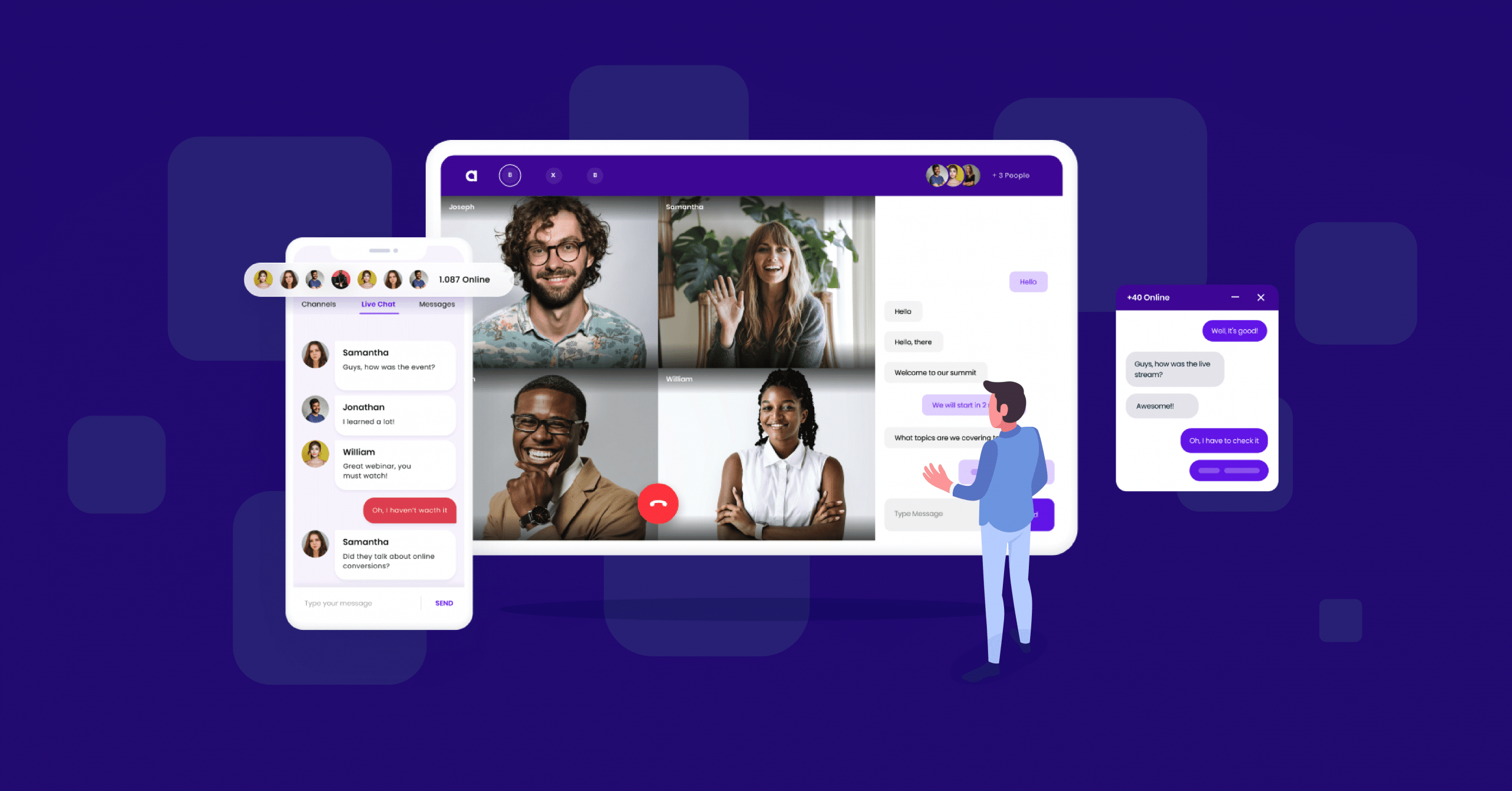How To Choose a Customer Engagement Platform For Your Virtual Event?
Selecting the perfect customer engagement platform for your virtual event involves evaluating key features, integrations, and pricing. Knowing what to prioritize can ensure smooth event management and optimize participant engagement.
What Are The Key Features To Look For?
When choosing a customer engagement platform, focus on features like live chat for real-time support, and customization capabilities for branding. Registration management and content delivery should be seamless, enabling easy sign-ups and smooth streaming. Scalability is also vital for handling varying audience sizes, from small webinars to larger conferences and virtual events.
It’s essential that the platform supports hybrid events, combining live and virtual elements. Engagement features, such as polls, Q&As, and interactive sessions, keep participants involved. Tools for gathering customer insights can help measure success and improve future events.
Which Platforms Offer the Best Integrations?
Integration capabilities are crucial for event planners. Platforms like HeySummit offer integrations with popular tools like Zoom and other virtual meeting solutions. This allows for streamlined event planning and execution without switching between multiple applications.
Look for platforms that integrate with CRM systems, email marketing software, and social media to maximize reach and effectiveness. Integrated analytics can provide a comprehensive view of attendee engagement and event performance. Choosing a platform with robust integration options can make managing online events more efficient and effective.
How Does Pricing Impact Your Choice?
Pricing significantly affects the choice of a customer engagement platform. Some platforms charge based on the number of attendees or events, as detailed in this guide to customer engagement platforms. It’s important to determine your budget and consider whether a subscription or a pay-as-you-go model is more cost-effective.
Evaluate what features are included in the pricing tiers. Basic plans might lack advanced features like detailed analytics or full customization. Compare different platforms to find a balance between cost and the functionalities you need. Highly-priced plans might offer better scalability and more robust engagement tools, making them suitable for large-scale virtual events.

How To Improve Your Online Store Metrics?
Improving your online store metrics involves focusing on key performance indicators, enhancing the user experience, and implementing effective marketing strategies. Targeted efforts in these areas can lead to better customer satisfaction and increased sales.
What Are The Key Metrics To Track?
Tracking the right metrics is crucial for understanding your online store’s performance. Some essential ecommerce metrics include:
- Conversion Rate: Measures the percentage of visitors who make a purchase.
- Average Order Value (AOV): Indicates the average amount spent per order.
- Customer Acquisition Cost (CAC): Calculates the cost to acquire a new customer.
- Customer Lifetime Value (CLV): Estimates the total revenue a customer will generate over their lifetime.
- Cart Abandonment Rate: Shows the percentage of shoppers who add items to their cart but do not complete the purchase.
Focusing on these key ecommerce metrics helps identify areas needing improvement and track the effectiveness of strategies implemented.
How Can Enhancing User Experience Help?
A positive user experience (UX) can significantly boost your online store metrics by making it easier for visitors to navigate, find products, and make purchases.
Simplify Navigation: Ensure your website is easy to browse with a clear menu structure.
Improve Load Speed: A fast-loading website reduces bounce rates and keeps users engaged.
Mobile Optimization: Ensure your site is mobile-friendly, as a significant portion of traffic comes from mobile devices.
Clear Calls to Action: Guide visitors towards making a purchase with clear and compelling calls to action.
By focusing on enhancing the user experience, you can reduce cart abandonment and increase conversion rates.
Which Marketing Strategies Prove Most Effective?
Effective marketing strategies can drive traffic and improve engagement on your online store.
- Email Marketing: Engages customers through personalized content, offers, and updates.
- Social Media Marketing: Builds brand awareness and drives traffic using various social platforms.
- SEO Optimization: Improves your site’s visibility on search engines, driving organic traffic.
- Paid Advertising: Uses targeted ads to reach specific audiences based on their preferences and behavior.
- Content Marketing: Provides valuable information through blogs, videos, and guides to engage and educate customers.
Employing these marketing strategies effectively can enhance overall traffic, engagement, and sales for your online store.
How To Engage Customers In A Virtual Environment?
Engaging customers in a virtual setting involves using various interactive methods and personalizing interactions to keep participants interested. These tactics can help overcome common issues like screen fatigue and distractions.
What Are Some Effective Engagement Tactics?
Using Interactive Sessions
Interactive sessions such as webinars or live Q&A can boost participant engagement. Virtual attendees enjoy being part of a conversation rather than just watching a presentation. This approach fosters a more immersive experience.
Incorporating Live Polls and Surveys
Live polls and surveys during events can gauge audience interest and gather their opinions in real-time. This not only keeps attendees engaged but also provides valuable insights for improvement.
Adding gamification elements like quizzes or challenges can make the virtual event more exciting. This creativity encourages active participation and makes the content more memorable.
Networking opportunities are crucial for virtual events. Creating breakout rooms or networking lounges allows attendees to connect and discuss topics of interest, which helps in building lasting professional relationships.
How Can You Personalize Customer Interactions?
Segmenting and Tailoring Content
Segment your audience based on interests or demographics. Then, tailor your content to these segments to make the interaction more relevant. This method can significantly enhance attendee engagement.
Using Personalization Tools
Tools like chatbots can offer personalized experiences by addressing attendees by name and suggesting content based on prior interactions. This creates a more customized experience for the user.
Sending Personalized Follow-Ups
After the event, send personalized follow-up emails. Mention individual contributions made during interactive sessions or provide custom resources. This personalization indicates that you value their participation.
Creating Breaks and Minimizing Screen Fatigue
Introduce short breaks and keep sessions brief to reduce screen fatigue. Breaks provide attendees time to absorb information and participate more actively when sessions resume.
Offering these personalized and interactive experiences ensures that virtual attendees remain engaged throughout the event. For further guidance, consider these seven tips to build excellent customer experience in virtual settings.
For more insight into choosing a platform, read about successful virtual customer engagement.
How To Utilize Data To Enhance Marketing Efforts?
Effective use of customer data can transform marketing strategies by providing insights into customer behavior and preferences. This allows marketers to target specific audiences more accurately, personalize campaigns, and optimize various marketing channels.
What Tools Can Help Analyze Customer Data?
Several tools are available to help marketers analyze customer data effectively. Customer Relationship Management (CRM) systems like Salesforce or HubSpot offer a comprehensive view of customer interactions and preferences. These platforms provide valuable insights that can drive sales and improve brand awareness.
Analytics platforms like Google Analytics track user behavior across websites, providing detailed reports on traffic sources, user engagement, and conversion rates. Tools like Mixpanel and Kissmetrics focus on user behavior analytics, helping marketers understand user actions and predict future behavior more accurately.
How To Turn Insights Into Actionable Strategies?
Turning insights into actionable strategies involves several steps. Segmentation is crucial; by dividing customers into smaller groups based on behaviors and demographics, marketers can create more targeted campaigns. This increases the effectiveness of email marketing and other outreach efforts.
Personalization is another key. Using data to tailor messages and offers to specific customer segments can significantly boost engagement and conversions. Marketers should also leverage automation tools to streamline processes. For example, email campaigns can be automated and personalized based on customer behavior data, ensuring timely and relevant communication.
Finally, integrating data-driven strategies into SEO efforts can enhance visibility and attract the right audience. By continuously analyzing and adjusting strategies based on real-time data, businesses can stay ahead of market trends and customer needs.
How To Optimize Your Ecommerce Platform?
Optimizing your ecommerce platform is essential for boosting sales and improving customer satisfaction. This involves choosing the right features and ensuring a seamless user experience.
Which Features Should You Prioritize?
When optimizing an ecommerce platform, specific features should be prioritized to cater to your target audience and enhance the customer journey. Flexibility and customization options are key. Platforms like WooCommerce and Shopify offer a range of customization tools that allow businesses to tailor their sites to their unique needs.
Customer engagement tools such as live chat and social media integration can significantly improve the shopping experience. For instance, integrating a live chat feature can address customer queries in real-time, increasing convenience and satisfaction.
Security is another critical feature. Ensure your platform supports SSL encryption and other security measures to protect customer data. Additionally, payment options should be diverse and user-friendly, including methods like credit cards, PayPal, and local payment solutions.
How To Ensure Seamless User Experience?
A seamless user experience is crucial in keeping customers engaged and encouraging repeat business. Navigation should be intuitive. A clutter-free interface helps users find what they need quickly, enhancing the customer experience. Implementing a user-friendly design with clear calls-to-action can guide users efficiently through their shopping journey.
Page load speed is also vital. Slow-loading pages can frustrate customers and lead to higher bounce rates. Optimizing images and leveraging content delivery networks (CDNs) can improve load times. Moreover, your platform should be mobile-responsive, ensuring inclusivity and accessibility.
Personalization can enhance the customer journey. Use data analytics to tailor product recommendations and content to individual users. Moreover, ensure your site adheres to accessibility standards, making it usable for everyone, including those with disabilities.
By focusing on these key aspects, businesses can create an engaging, convenient, and accessible ecommerce experience for their customers.
How To Measure The Success Of Your Customer Engagement Strategy?
To measure the success of your customer engagement strategy for a virtual event, it’s essential to focus on specific metrics, regularly assess performance, and use the right tools to track progress. This approach ensures you capture valuable insights and make informed decisions.
What Metrics Should You Focus On?
Key metrics for evaluating customer engagement include Net Promoter Score (NPS), which gauges customer loyalty and satisfaction. Customer Satisfaction Score (CSAT) measures attendees’ satisfaction with the event.
Time on Site is another critical metric, showing how long visitors stayed engaged with your event. Engagement Rate tracks interactions like comments, shares, and reactions. Additionally, Customer Retention Rate evaluates how well your strategy keeps attendees coming back for future events. Event analytics can further provide valuable insights into your audience’s behavior and preferences.
How To Conduct Regular Assessments?
Regular assessments involve collecting and analyzing data to track the performance of your engagement strategy. You should conduct surveys to gather customer feedback. Feedback helps in understanding what attendees liked and where improvements are needed.
Weekly or monthly reviews of key metrics are essential. Use dashboards for a visual representation of your performance indicators. Compare current data with past results to detect trends and identify areas for improvement. Meeting with your team to discuss findings and action plans ensures everyone is aligned and proactive in enhancing the customer experience.
What Tools Can Help Track Progress?
Various tools can assist in tracking the progress of your customer engagement strategy. Customer Relationship Management (CRM) software centralizes customer interactions and provides detailed analytics. Tools like Google Analytics help monitor attendee engagement.
Survey platforms such as SurveyMonkey allow for easy collection of customer feedback. Social media analytics tools track interactions across your channels.
Using a combination of these tools helps create a comprehensive view of how well your strategy engages customers and supports improvements in future virtual events.
Frequently Asked Questions
Choosing the right customer engagement platform for virtual events involves understanding key features, comparing different platforms, and implementing strategies to boost attendee engagement. It also includes effective promotion tactics, considering feedback, and transitioning smoothly from in-person to virtual events.
What features should I look for in a customer engagement platform for virtual events?
Look for features that enable seamless interaction, such as live chat, polls, and Q&A sessions. Integration with social media channels is also crucial for broader reach. Analytical tools for measuring engagement and ease of use are important too.
How can I compare different virtual event platforms to find the best fit?
Compare platforms based on ease of use, customization options, and integrations. Check if the platform supports large-scale events without performance issues. Look for reviews and ask for demos to see how the platform handles essential functions like event registration, scheduling, and communication.
What strategies can be implemented to boost attendee engagement in virtual events?
Incorporate interactive elements such as live polls and Q&A sessions. Use gamification techniques like quizzes and contests. Utilize engaging content and leverage social media platforms like Facebook and LinkedIn for real-time engagement. Create breakout sessions for more focused and personalized interactions.
Can you provide tips for effectively promoting a virtual event in advance?
Start promotions early using email campaigns and social media advertisements. Use teaser videos to generate interest. Partner with influencers to reach a wider audience. Offer early bird discounts to encourage quick registrations. Create engaging posts on platforms like LinkedIn and Facebook to drive awareness.
How does attendee feedback influence the choice of a virtual event platform?
Collect feedback on what attendees liked and areas needing improvement. Use surveys post-event to gather insights on functionality and engagement. Look for common suggestions and recurring issues. Choose a platform that addresses these concerns and has features to enhance user experience.
What considerations are important when transitioning from in-person to virtual event platforms?
Understand the differences in execution between in-person and virtual events. Make sure the chosen platform supports various event types like webinars and product launches. Consider the challenges of engaging participants virtually and plan for community building. Make use of the platform’s advantages to bridge the gap created by the pandemic.



